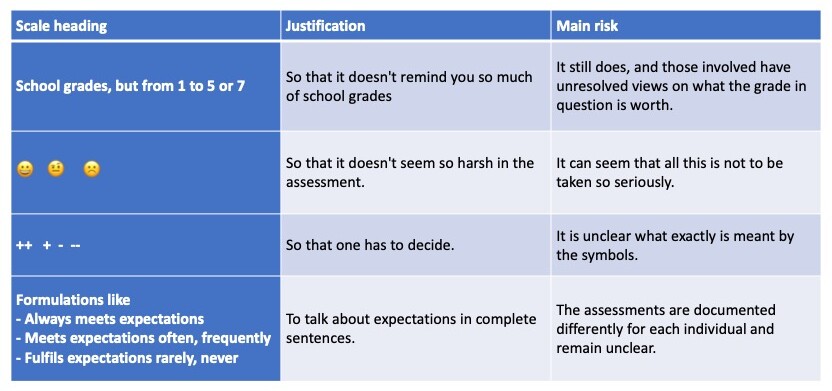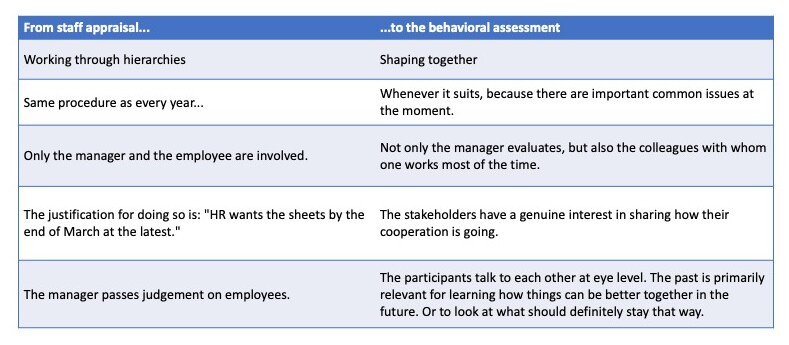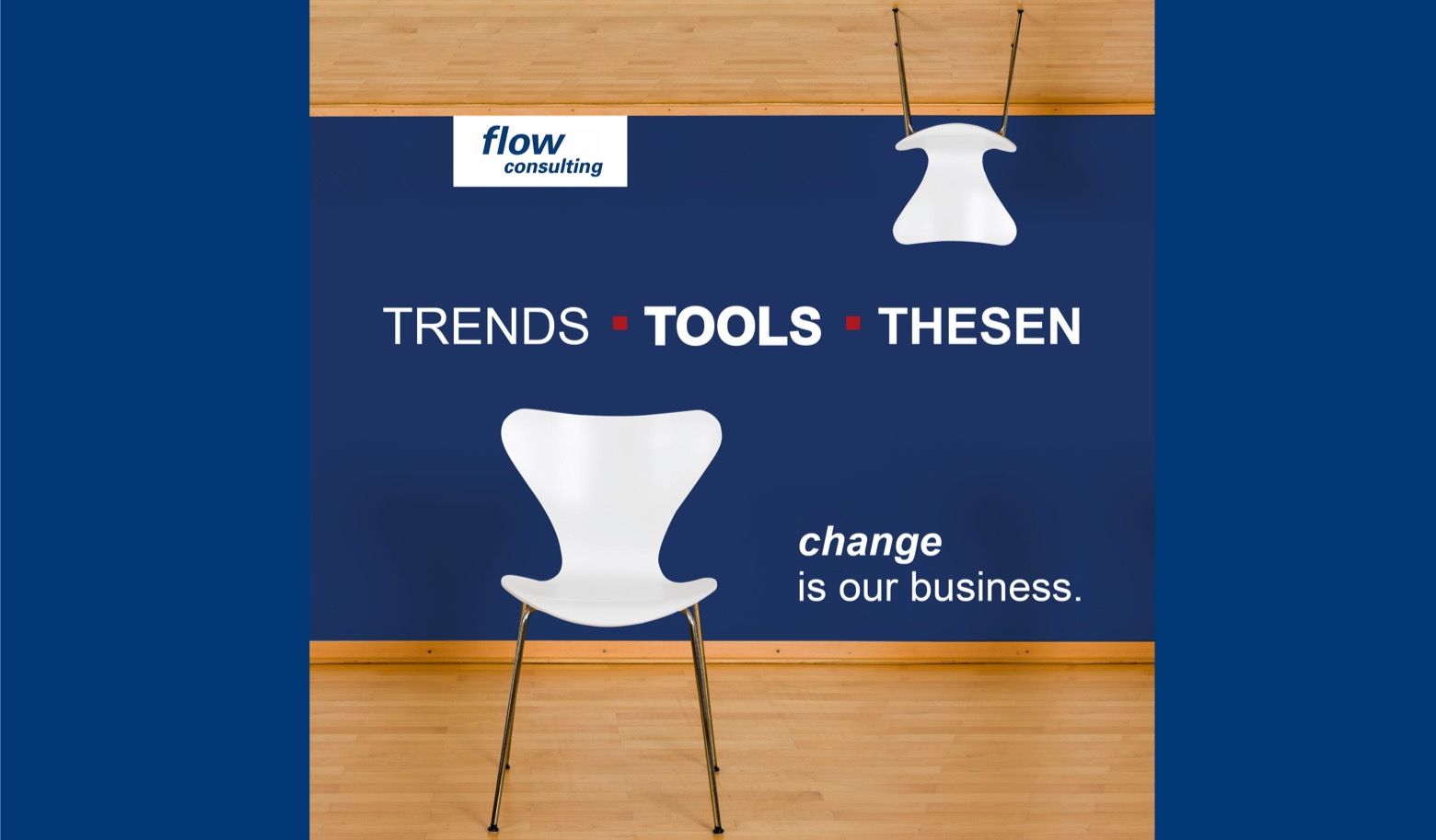In our new podcast episode (German language), you can hear what the benefits are of moving away from staff appraisals to behavioral appraisals and which first steps you should take.
Podcast: Play in new window | Download
Actually, the title should be “Same procedure as every year”. That actually fits the season quite well. Because in most companies it’s that time of year again: annual appraisals have to be conducted, or should we say “personnel appraisals”. The word itself has a strange connotation, don’t you think? And unfortunately, in practice, the following situation still frequently occurs: two people sit opposite each other and are systematically – I would almost like to say – forced to talk to each other. In our counselling practice we rarely hear about voluntariness in this context. But let’s take it one step at a time.
On the nature of staff appraisal
The justification for carrying out annual appraisals is mostly: “The HR department wants the sheets by the end of March at the latest.” And in the worst case scenario, it goes as the name suggests: the manager passes judgement on the employees. They can object and document this, but as a consequence such formal steps usually remain ineffective. The forms, whether they are filled out on paper or stored digitally, disappear into oblivion. Or they are only looked at again after a year, without the parties involved having made any effort to implement the agreed measures in the meantime. So the conclusion in people’s minds is “It’s no use anyway.” – a pity.
But why is that? Our experience shows that it is not just a question of the managers’ discussion skills, but that their working basis is often no longer up to date. Even if they wanted to, by system it is almost impossible to have a good dialogue with the prescribed documents.
The problem with assessment scales and criteria
Are you familiar with such column headers on staff appraisal sheets? This is only a small excerpt from the multitude of variants we find in companies.

Then there are the appraisal criteria. Classic examples are the terms flexibility, ability to work under pressure, independence, creativity, ability to work in a team, willingness to work hard, etc. These have been the subject of criticism in professional circles for years, as can be read in the book Personal-Management (Berthel/Becker, Schäffer-Poeschel-Verlag). This is because they do not discuss observable concrete behaviour, but rather (pre-)judge the personality or characteristics of people.
Result: Frustration at the end of the talks
- For the managers, because they hardly succeed in achieving a goal-oriented and motivating result with the prescribed system.
- The employees are left with a sour aftertaste. Among other things, it is unclear what he or she is supposed to work on and how he or she can develop.
Why do we still work with such an – sorry – outdated instrument? My colleague Frank Wippermann gives a simple answer to this question in his book Future Skills für Führung und Organisation: Because everyone has got used to it and firmly believes that nothing can be changed anyway.
From staff appraisal to behavioural assessment
Now the question arises how such leadership instruments have to be changed in order to achieve a result that not only helps the people involved, but above all the company. You can find a few suggestions on this in our new podcast episode and here:

And beyond that, it’s worth thinking about the following aspects:
- A changed mindset: It is no longer about one-sided assessment, but about mutual assessments. The prerequisites for this are: A culture of trust as well as employees and managers who have been empowered to handle feedback professionally.
- Points, smileys and grades are no longer used in favour of examples that those involved can still understand afterwards. Whether, what and how much is documented is left to the discretion of those involved.
- Personality traits are first translated into concrete behaviour. Thus, “ability to work in a team” simply becomes “behaviour in a team”. And this is shown, for example, by one team member supporting, informing, accepting, involving the other, etc.
- Not all behaviour is the same in every workplace. “Always respond to the wishes of others with understanding” is very desirable in service, but probably not in auditing. At the beginning of the talks, it makes sense to first discuss which requirements were relevant for the performance of the task and whether this should also be the case in the future.
- Whether the participants agree on measures or not is also decided on their own responsibility.
- … and much more.
Sociologist Giuseppe Bonazzi describes the underlying attitude in his book “Geschichte des organisatorischen Denkens” (p. 241) as follows: “What is needed here are competitive, dynamic, responsible individuals who show initiative, are full of ideas, reject any fossilisation of time-honoured procedures and love the new.”
Practising leadership skills
Moving away from the classic version of personnel appraisal requires a changed mindset. Human resource management must provide new systems to arrive at behavioural assessment. Training in leadership competencies is necessary in order to be able to point out perspectives, provide orientation and support and – as simple as it sounds – to have good conversations with employees. The latter must be enabled to follow the new ‘course’. This begins with the preparation of a behavioural assessment, continues with the discussion itself and also includes the independent implementation of the agreements.
You know that we are happy to support you in this 😉 And now I wish you further helpful insights from my conversation with Frank Wippermann. By the way, he has some clear advice on the subject of “personnel appraisal and the Gaussian normal distribution curve”…
Kind regards
You can also find our podcast on Spotify and Apple Podcasts.



